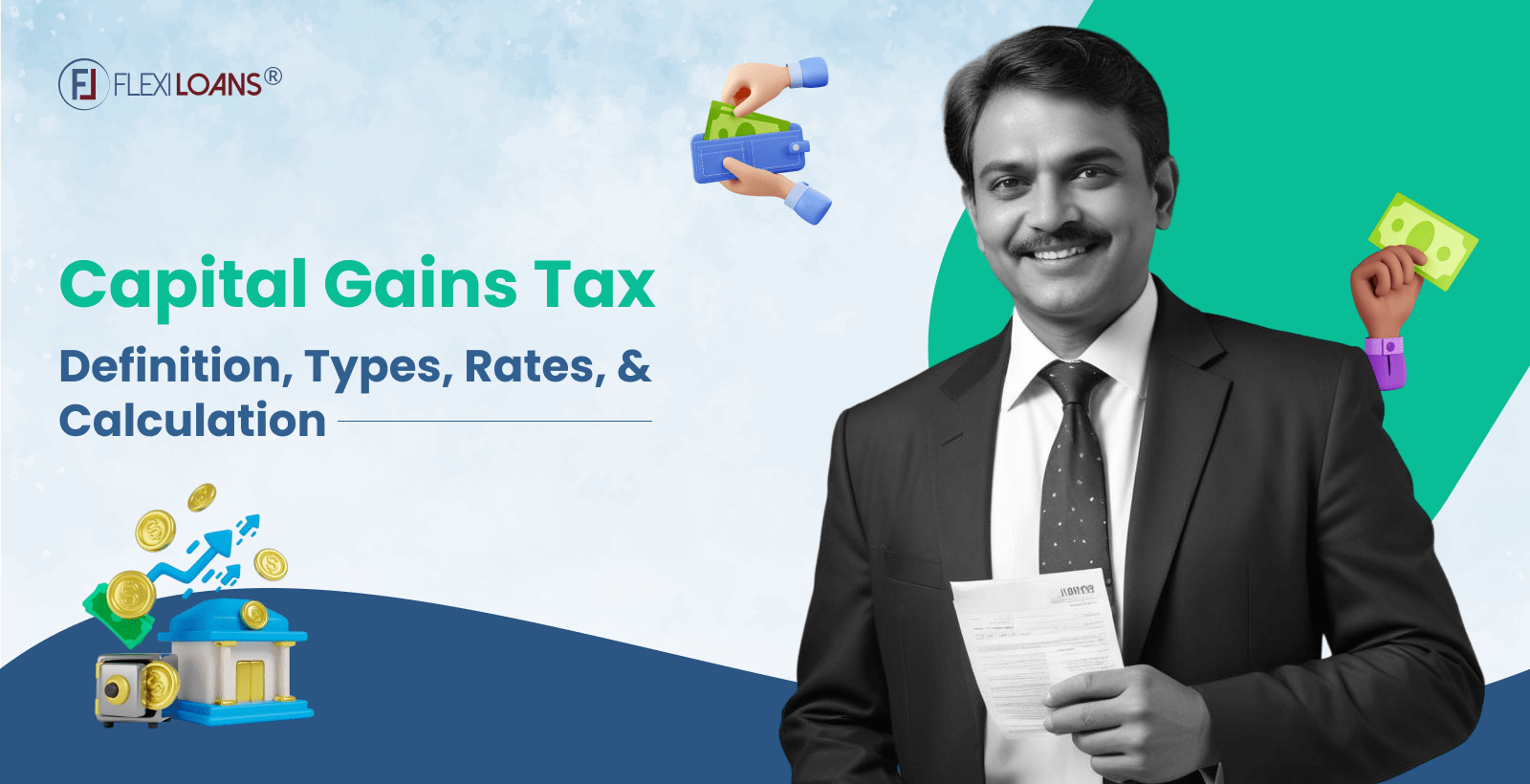Aug 29, 2024
Nov 29, 2025

When you own an asset like property, shares, or mutual funds, understanding the nuances of capital gains tax (“CG tax”) becomes crucial. This guide simplifies the complexities of this tax, covering its definitions, types, rates, and the calculation process. You’ll also learn about available exemptions and the latest tax rule changes related to mutual funds.
What is a Capital Asset?
Before exploring CG tax, let’s clarify what qualifies as a capital asset. A capital asset refers to any property you own, whether connected to your business or not. This category includes tangible assets like land, buildings, houses, cars, jewellery, machinery, and intangible assets like patents, trademarks, or leasehold rights.
Assets not considered capital assets include:
- Stock-in-trade, raw materials, or consumables used in your business
- Personal effects like clothes, furniture, and cars (excluding jewelry and ornaments)
- Agricultural land in rural India
- Gold bonds issued by the government
Types of Capital Gain
This occur when you sell a capital asset for more than its purchase cost. The profit you earn from this sale falls under CG. You can classify these into two categories based on how long you held the asset.
- Short-Term (STCG): These occur when you sell a capital asset within a short holding period. For example, if you sell a property within two years of purchasing it, you classify the profit as short-term capital gains.
- Long-Term (LTCG): These occur when you hold a capital asset for a longer period before selling it. For instance, selling a property after holding it for more than two years results in long-term capital gains.
Table for Asset Holding Period
| Asset Type | Short-Term Holding Period | Long-Term Holding Period |
|---|---|---|
| Property (Immovable) | Up to 24 months | More than 24 months |
| Equity Shares | Up to 12 months | More than 12 months |
| Debt Mutual Funds | Up to 36 months | More than 36 months |
| Gold/Jewellery | Up to 36 months | More than 36 months |
| Unlisted Shares | Up to 24 months | More than 24 months |
Your asset’s holding period directly impacts the rate applicable to your profits.
Also Read about Working Capital Loan Vs Term Loan
How Are Capital Gains Calculated?
You can calculate the tax based on whether they are short-term or long-term
- Short-Term (STCG):The formula for calculating short-term capital gains:
- Short-Term Capital Gains = Sale Price − (Cost of Acquisition + Cost of Improvement + Expenses on Transfer)
- Long-Term (LTCG):The formula for calculating :
Long-Term Capital Gains = Sale Price − (Indexed Cost of Acquisition + Indexed Cost of Improvement + Expenses on Transfer)
Indexed Cost of Acquisition
Indexation plays a crucial role in calculating long-term capital gains. By adjusting the purchase price of your asset based on the inflation index, indexation lowers your taxable gains and reduces your tax liability.
Formula for Indexed Cost of Acquisition:
Indexed Cost of Acquisition = (Cost of Acquisition× Cost Inflation Index (CII) of Sale Year) / CII of Purchase Year
Cost of Improvement That Is Indexed
Just like the indexed cost of acquisition, you also index the cost of improvements made to the asset. This adjustment reflects the actual improvement cost, considering inflation.
Formula for Indexed Cost of Improvement:
Indexed Cost of Improvement=(Cost of Improvement× CII of Sale Year) / CII of Improvement Year
How Should One Compute Short-Term Capital Gains?
Calculating short-term capital gains remains straightforward since indexation doesn’t apply to these gains. To compute your short-term gains accurately, follow these steps:
- Determine the Sale Price: Start by identifying the sale price, which is the amount for which you sold the asset. This figure forms the basis of your calculation and represents the gross proceeds from the sale.
- Subtract the Cost of Acquisition: Next, deduct the original purchase price, known as the cost of acquisition. This cost includes the price you paid to acquire the asset, along with any related expenses such as stamp duty and registration fees. By subtracting this amount, you account for the initial investment you made.
- Subtract the Cost of Improvement: If you’ve made any improvements to the asset, such as renovations or upgrades, deduct these costs from the sale price. The cost of improvement includes expenses directly related to enhancing the asset’s value, which can help reduce the taxable gain.
- Subtract Transfer Expenses: Finally, deduct any expenses incurred during the transfer of the asset. These expenses can include brokerage fees, legal charges, advertising costs, or any other costs directly associated with the sale. By subtracting these expenses, you account for the costs involved in completing the sale.
The result of these calculations is your short-term capital gain. This gain is then subject to taxation according to the applicable tax slab based on your total income, making it essential to calculate each component accurately to ensure you pay the correct amount of tax.
Exemptions of Tax on Capital Gains
The Income Tax Act offers several exemptions, allowing you to reduce your tax liability. Some common exemptions include:
- Section 54: Exemption on long-term capital gains from selling residential property if you invest the gains in purchasing or constructing another residential property.
- Section 54F: Exemption from selling any asset other than residential property, provided you reinvest the gains in purchasing a residential property.
- Section 54EC: Exemption on long-term capital gains if you reinvest the gains in specific bonds, such as those issued by the National Highways Authority of India (NHAI) or Rural Electrification Corporation (REC).
These exemptions offer significant tax-saving opportunities if you plan your investments strategically.
Capital Gains Tax on Debt and Equity Mutual Funds
Mutual funds, a popular investment option, have specific rules:
- Equity Mutual Funds: Holding equity mutual funds for more than one year results in long-term capital gains, taxed at 10% without indexation if the gain exceeds ₹1 lakh. Short-term gains face a 15% tax.
- Debt Mutual Funds: For debt mutual funds, a holding period of more than three years qualifies the gains as long-term. These gains are taxed at 20% after indexation, while short-term gains are added to your income and taxed as per your income tax slab.
Debt Mutual Funds – Change in Tax Rule
Recent changes in tax rules for debt mutual funds have a significant impact. Previously, long-term capital gains from debt mutual funds received indexation benefits. However, under the Finance Act, 2023, debt mutual funds acquired after 1st April 2023 and held for over three years no longer enjoy indexation. These gains are now taxed according to the investor’s tax slab, leading to a higher tax outgo.
When Can a Person Invest in a Capital Gains Account Scheme?
To claim exemptions under Sections 54 and 54F, you must invest in a new residential property before filing your income tax returns. If you can’t complete the purchase or construction of the new property before the due date, deposit the gains in a Capital Gains Account Scheme (CGAS). This strategy lets you claim the exemption and use the funds for the new property purchase later.
Agricultural Land Tax
Agricultural land holds a special place in tax rules. Agricultural land in rural areas is exempt from capital gains tax. However, you consider urban agricultural land a capital asset, and selling it incurs CG tax. Knowing the location of the land is vital for determining tax applicability.
Section 54B: Exemption for Agricultural Purpose
Section 54B offers an exemption on capital gains from selling agricultural land. If you sell agricultural land and purchase another piece of agricultural land within two years, you can claim an exemption. This exemption applies only to individuals or Hindu Undivided Families (HUFs) and promotes agricultural activities.
Cost Inflation Index Number
The Cost Inflation Index (CII) plays a key role in determining the indexed cost of acquisition and improvement. The government notifies the CII each year, representing the inflation rate. Applying the CII adjusts the purchase price of your asset to reflect inflationary changes, reducing your taxable income.
Here’s a quick example:
If you bought a property in 2010 for ₹50 lakh and sold it in 2023 for ₹1 crore, and the CII for 2010 was 711 and for 2023 is 348, the indexed cost of acquisition would be:
Indexed Cost of Acquisition=(50,00,000×348) / 711 = ₹24,47,189
You then calculate your long-term capital gains by subtracting ₹24,47,189 from ₹1 crore, rather than the original ₹50 lakh.
Understanding CG tax is crucial for effective financial planning and ensuring you maximise your returns while minimising tax liabilities. Whether dealing with short-term or long-term capital gains, knowing the rules, exemptions, and calculations can significantly impact your investment strategy. By leveraging indexation, exemptions under various sections, and tools like CG tax calculators, you can make informed decisions that align with your financial goals.
If you’re looking to expand or start a new venture, securing the right funding is just as important. Whether you need a loan for business expansion, purchasing new equipment, or boosting your working capital, FlexiLoans offers tailored solutions to meet your needs. You can easily apply for a business loan through their online business loan application process, which ensures fast approvals and minimal paperwork.
FlexiLoans also provides specialised options, such as machinery loans and business loans for women, making it easier for you to access the funds necessary to drive your business forward. With quick business loans available across India, from business loans in India to those specifically catered for women entrepreneurs, FlexiLoans ensures that your financial needs are met efficiently and effectively. Whether you’re looking for business loans online or exploring opportunities for growth, FlexiLoans is your trusted partner in business finance.
Also Read about Different Types of Assets in Business
FAQs
Understanding the types is crucial because the tax rates and exemptions differ significantly between short-term and long-term CG. This knowledge helps you make informed decisions about your investments and tax planning.
The Finance Act, 2023, removed the indexation benefit for debt mutual funds acquired after 1st April 2023 and held for more than three years. The gains are now taxed as per the investor’s tax slab, leading to higher taxes.
FlexiLoans makes it easy for businesses to get loans sanctioned by offering a hassle-free online application process, minimal documentation, and quick disbursals. Whether you need a loan for business expansion or working capital, FlexiLoans provides tailored solutions to meet your needs.
You can minimize your tax liability by strategically using exemptions under sections like 54, 54F, and 54EC. Investing in a CGAS also helps defer tax liability when planning to reinvest in property.
Yes, you can claim an exemption under Section 54 if you reinvest the long-term capital gains from selling a residential property into purchasing or constructing another property within the specified time frame.
The Cost Inflation Index (CII) adjusts the purchase cost of your asset for inflation, which reduces your taxable long-term capital gains and consequently lowers your capital gains tax liability.







